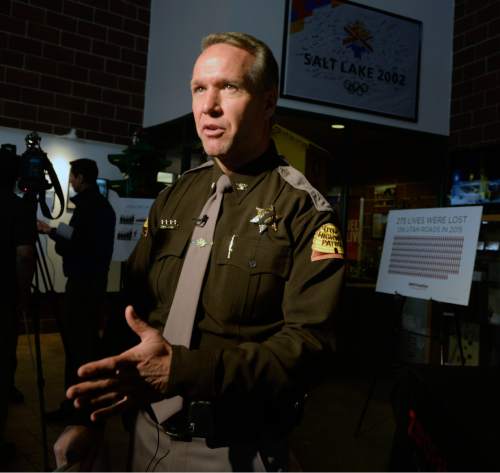This is an archived article that was published on sltrib.com in 2016, and information in the article may be outdated. It is provided only for personal research purposes and may not be reprinted.
Utah roads are becoming deadlier. Last year, 275 people died on them — up from 256 in 2014 and 220 in 2013.
That's a jump of 7 percent over one year and 25 percent over two years.
"We're going the wrong direction," Daniel Fuhr, superintendent of the Utah Highway Patrol, said Tuesday as the state released preliminary statistics for the year.
He said the increase may have resulted, in part, from more people traveling more miles because of lower gas prices, a mild winter last year and a growing population. But he places most of the blame on another major factor.
"The increase is because simply 93 percent of the crashes are from human behavior and error," he said. "The increase is because people aren't listening to our message. We tell people, 'Wear you seat belts.' But our seat-belt fatalities are increasing. 'Don't drive impaired,' but our DUI fatalities are increasing. 'Drive the speed limit,' but our speed-related fatalities are increasing. We just need to listen."
Recent increases in fatalities come after a long decline between 2002 and 2012, when annual Utah road deaths had decreased from 329 to 217. They have gone up every year since then.
Carlos Braceras, executive director of the Utah Department of Transportation, said the group with the biggest jump in fatalities last year was pedestrians.
"Two years ago, we were at 30 pedestrian deaths. We went to 37 in 2014. Now we are at 47," he said. "Most of those were in crosswalks or at intersections. It's surprising to us." He added that four of the 11 highway deaths so far in 2016 also involved pedestrians.
So he said the state will launch a new program of ads and education, called "Heads Up," that in part will urge drivers to look for and be aware of pedestrians, bikers and motorcyclists.
"It's not spending even a second to look at your phone or to turn away," he said, "even to adjust the radio."
Braceras noted the campaign will remind bikers and pedestrians to expect the unexpected from drivers because "when you're on your bicycle or walking, you don't have the protection of a 4,000-pound vehicle around you."
One thing officials say did not cause the extra deaths was increasing the speed on urban freeways in December 2014 to 70 mph and raising the speed limit to 85 mph on additional stretches of rural interstates last year.
"We don't see any evidence that the increase in posted speed affected the fatality numbers," Braceras said.
He explained that "75 percent of our fatalities are not on the interstates," but on smaller roads. "If you look year over year, it sits at about the same percentage," and the higher speed limit apparently did not boost freeway deaths.
Fuhr said speed was determined to be a factor in 58 deaths during 2015, but most of the vehicles involved were going well beyond the speed limit — or were traveling too fast for conditions during bad weather.
He said the new higher speed limits themselves did not appear to be a factor in those fatalities.
The state released numerous statistics about the deaths, including:
• Among those who died, 187 were motorists, 47 were pedestrians, 36 were motorcyclists and five were bicyclists.
• Leading causes included: improper restraint, 86 victims (31 percent of the total); DUI, 75; aggressive driving (including 58 that involved speed), 64; distracted driving, 27; and drowsy driving, 14. Some accidents involved multiple reasons.
• The deadliest roads, by total victims, were: Interstate 15, 36; U.S. 89, 13; Interstate 80, 12; Interstate 70, 10; U.S. 6, 11; and U.S. 40 and State Road 68, seven each.
• Most fatal accidents occurred during good weather conditions: 81 percent when roads were dry and 70 percent when the weather was clear.
• Counties with the most fatalities were: Salt Lake, 74; Utah, 37; Weber, 20; Washington, 17; Box Elder, 16; and Tooele, 15.
Utah, for years, has operated its Zero Fatalities educational program seeking to lower the highway death rate. Braceras and Fuhr said it is painful to see statistics go the opposite direction despite that program.
"People often mock the Zero Fatalities campaign, and say there is no way we can have zero fatalities," Fuhr said. "Well, what's acceptable? Is it acceptable for a member of your family to be one of those fatalities? Absolutely not."
Officials noted that Utah did have 176 days last year with no fatalities. Also, Garfield, Juab, Piute and Rich counties had no road deaths that year. Fuhr said it helps show the goal can be achievable "if people listen to our message."



